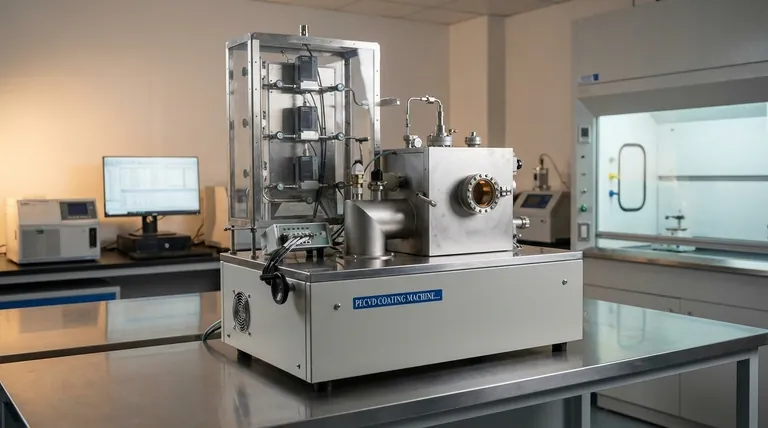The primary advantages of plasma deposition are its exceptional versatility and the superior physical properties it imparts to finished products. This advanced manufacturing technique allows for the application of highly durable, scratch-resistant coatings onto a vast range of materials and complex shapes, fundamentally enhancing their performance and longevity.
Plasma deposition is not merely a coating method; it is a surface engineering tool. It allows for the precise creation of thin films with enhanced physical properties, like extreme hardness, on virtually any object, regardless of its size or geometric complexity.

What Makes Plasma Deposition Different?
Plasma deposition, often a form of Physical Vapor Deposition (PVD) or Plasma-Enhanced Chemical Vapor Deposition (PECVD), is a process that occurs in a vacuum. It involves creating a plasma, an energized state of gas, to deposit material atom by atom onto a substrate. This atomic-level control is the source of its key benefits.
The Power of Plasma
Plasma is often called the fourth state of matter. By energizing a gas, we create a reactive environment of ions and electrons that can be precisely manipulated.
This controlled environment allows for the deposition of a thin film that is incredibly dense, uniform, and strongly bonded to the underlying surface.
Not Just a Layer, but an Engineered Surface
Unlike traditional painting or plating, plasma deposition builds a new surface with intrinsically superior characteristics. This is the difference between applying a coat of paint and fundamentally changing the properties of the material's surface itself.
The Core Advantages Explained
The unique nature of the plasma process translates into two significant, practical advantages for manufacturing and product design.
Unmatched Versatility
Plasma deposition is remarkably flexible. It can be used to apply a wide array of materials, from metals and ceramics to specialized polymers.
This process is not limited to flat, simple objects. Because the plasma can surround an object, it can uniformly coat complex, three-dimensional shapes and intricate geometries that are impossible to cover with line-of-sight methods.
Superior Physical Properties
Products created through plasma deposition benefit from excellent physical performance that goes far beyond simple aesthetics.
The resulting coatings are known for outstanding hardness and scratch resistance. This is because the atomic bonding process creates a very dense, well-adhered layer with minimal defects, significantly increasing the durability of the underlying object.
Understanding the Trade-offs
While powerful, plasma deposition is a specialized technique with its own set of considerations. True expertise requires understanding both its strengths and its limitations.
Process Complexity and Equipment
This is not a simple workshop process. Plasma deposition requires sophisticated equipment, including vacuum chambers, high-power energy sources, and precise gas control systems.
Operating this equipment effectively demands a high level of technical expertise to control the many variables that influence the final coating's quality.
Cost and Cycle Time
The initial capital investment for plasma deposition equipment can be significant. Furthermore, deposition rates can be slower than bulk coating methods.
For these reasons, it is best suited for applications where the performance gains—such as extreme durability, biocompatibility, or specific optical properties—justify the investment.
How to Apply This to Your Project
Choosing the right manufacturing process depends entirely on your end goal. Plasma deposition offers a distinct set of capabilities for high-performance applications.
- If your primary focus is extreme durability and wear resistance: Plasma deposition offers superior hardness and scratch resistance that traditional coatings often cannot match.
- If you are working with complex shapes or sensitive materials: The conformal nature of the process makes it ideal for uniformly coating intricate objects without causing thermal damage.
- If your priority is high-volume, low-cost production: You must carefully weigh if the significant performance benefits of plasma deposition justify the investment over simpler, faster coating methods.
Ultimately, plasma deposition empowers you to engineer surfaces with precisely controlled, high-performance characteristics that are unattainable with conventional methods.
Summary Table:
| Advantage | Key Benefit |
|---|---|
| Versatility | Coats complex 3D shapes & various materials (metals, ceramics, polymers) |
| Superior Properties | Extreme hardness, excellent scratch resistance, and strong adhesion |
| Conformal Coating | Uniform coverage on intricate geometries, not just line-of-sight |
| Engineered Surface | Creates a dense, high-performance layer, not just an applied coating |
Ready to engineer superior surfaces for your high-performance components?
Plasma deposition from KINTEK delivers the durability and precision your laboratory or manufacturing process demands. Whether you need to enhance wear resistance, coat complex geometries, or achieve specific functional properties, our expertise in lab equipment and consumables ensures optimal results.
Contact us today to discuss how plasma deposition can solve your coating challenges and add value to your products. Get in touch via our contact form for a personalized consultation.
Visual Guide

Related Products
- Inclined Rotary Plasma Enhanced Chemical Vapor Deposition PECVD Equipment Tube Furnace Machine
- RF PECVD System Radio Frequency Plasma-Enhanced Chemical Vapor Deposition RF PECVD
- Chemical Vapor Deposition CVD Equipment System Chamber Slide PECVD Tube Furnace with Liquid Gasifier PECVD Machine
- Customer Made Versatile CVD Tube Furnace Chemical Vapor Deposition Chamber System Equipment
- Electron Beam Evaporation Coating Oxygen-Free Copper Crucible and Evaporation Boat
People Also Ask
- What is plasma enhanced chemical vapour deposition process? Unlock Low-Temperature, High-Quality Thin Films
- What is meant by vapor deposition? A Guide to Atomic-Level Coating Technology
- What materials are deposited in PECVD? Discover the Versatile Thin-Film Materials for Your Application
- What is PECVD silicon deposition? Achieve Low-Temperature, High-Quality Thin Films
- How does plasma enhanced CVD work? Achieve Low-Temperature, High-Quality Thin Film Deposition



















